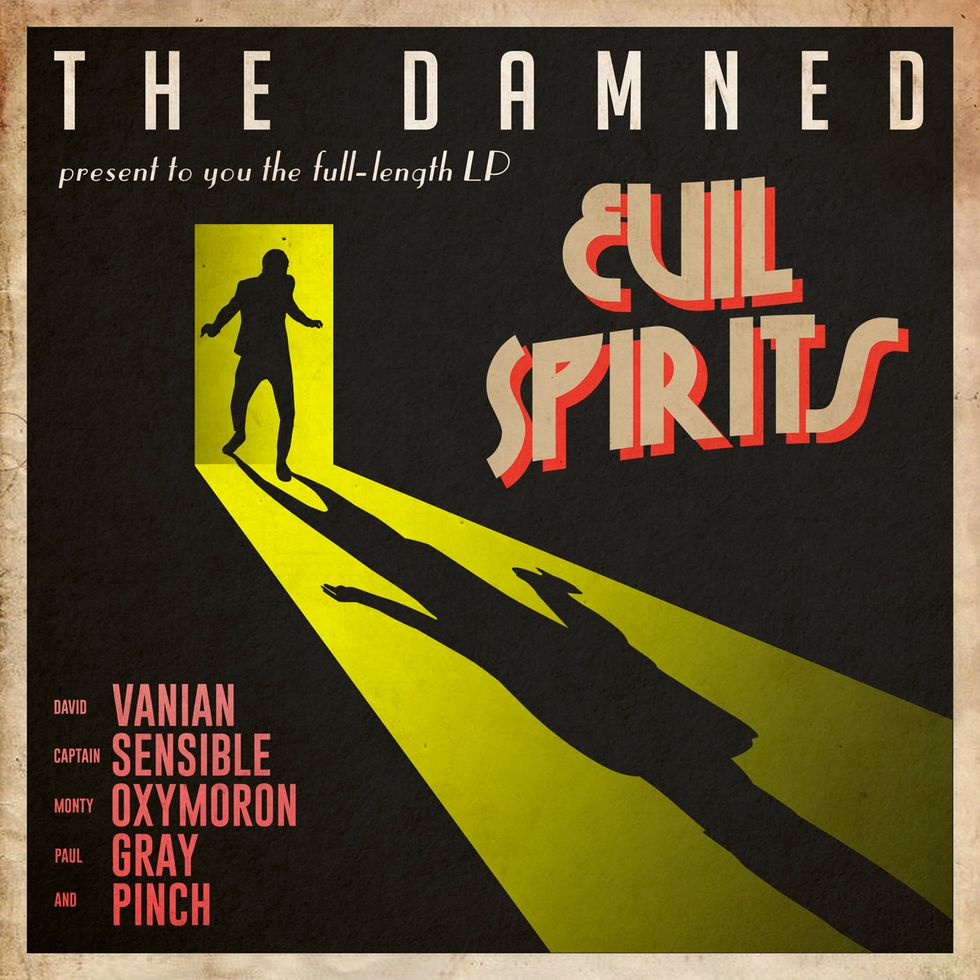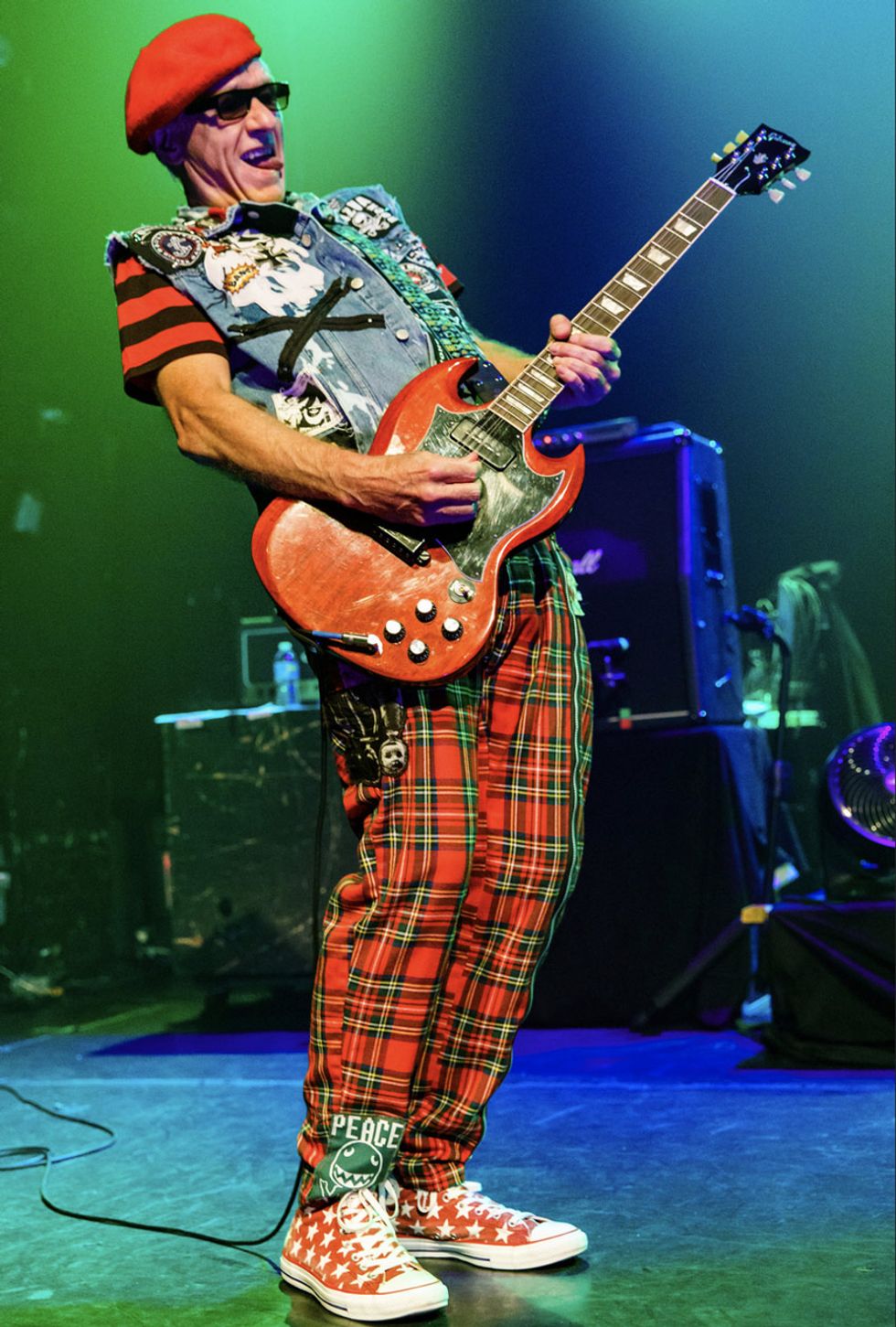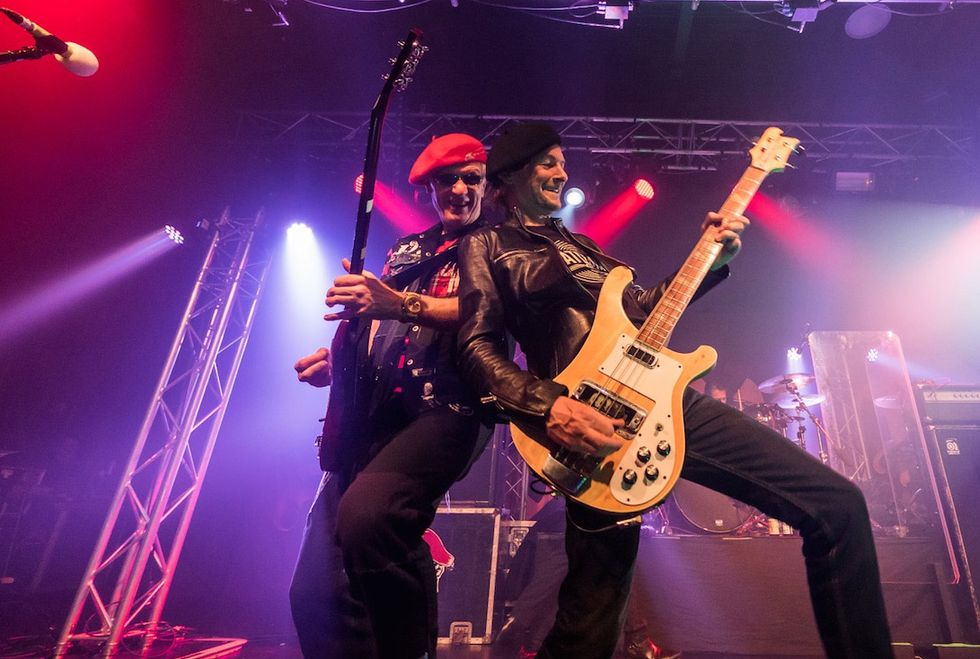Punk rock has morphed, been bastardized, revitalized, and analyzed infinitely since becoming a defined movement in the late ’70s. However, first-generation punks the Damned don’t care much about any of that. They’ve been far too busy touring to devote time to nostalgia. Now—42 years since they became the first of the British punk groups to put out a single, with 1976’s “New Rose,” beating the Sex Pistols by a month, and 10 years since their last studio album, So, Who’s Paranoid?—the Damned have returned with Evil Spirits, an album that bristles with the vitality, immediacy, and irrepressible creativity that’s earned them the distinction of being one of the most important punk bands of all time.
Genre politics and hyperbole aside, the Damned have always been the musicians’ band among the classic punks, and the group has always operated with a policy of lawlessness when it comes to the music they make. The Damned’s vision of punk has included liaisons with deep psychedelia, piano-driven pop, farfisa-dotted slam-dance anthems, and proto-goth—all laced up with the anger and devil-may-care attitude that made punk punk. While the Damned are fronted by a crooning vampire-poet of a man in Dave Vanian, much of the group’s sweeping sonic vision has hinged upon the guitar work, songcraft, and imagination of founding member Captain Sensible (born Raymond Burns).
Although the Captain was stationed on bass for the Damned’s first few recordings, he emerged on the group’s third album, 1979’s Machine Gun Etiquette, as a dexterous and melodic guitarist with a knack for penning killer hooks that draw on a surprisingly vast range of influences. A fan of British blues-rock players like the Groundhogs’ Tony McPhee and Free’s Paul Kossoff, and of Summer of Love psych-rock and the pomp of ’60s orchestral pop music, the Captain has never relied merely on power chords and beer—although those have often been a part of his recipe.
And while his technical prowess has been overshadowed by his giant personality and tucked away within the confines of excellent songs, Evil Spirits puts his cadre of guitar-borne personas on display as he chunks, clatters, burns, and jangles through the album’s tracks.
Produced by the venerable Tony Visconti (best known as the helmsman of classic David Bowie and T. Rex albums), Evil Spirits sees the return of the Captain’s favored bass guitar sparring partner, Paul Gray, to the Damned for the first time in nearly a decade. Gray’s recorded output with the Damned includes two of the band’s most revered and musically fibrous albums, Strawberries (1982) and The Black Album (1980). Unsurprisingly, Evil Spirits sounds very much like a continuation of the sonic tack the group were on at that point in their career. A true athlete when it comes to traversing the fretboard of a Rickenbacker bass, Gray’s “lead bass” style and the way his playing seamlessly weaves with the Captain’s is a massive part of Evil Spirits’ musical bedrock.
Premier Guitar sought an audience with Sensible and Gray to discuss the making of the Damned’s triumphant return to studio recording, their philosophies and roots as players, the symbiosis that exists within their playing relationship, and even a bit of gear geekery.
Paul, you’ve name-checked unexpected influences for a guy who’s made his bones playing punk: particularly Felix Pappalardi from Mountain and Roger Glover of Deep Purple.
Paul Gray: I was always drawn to the bass end for some reason. The bass player always looked the coolest in the band! They weren’t making silly faces and all that like the other guys. I loved guys like Jim Lea from Slade, who was doing more like lead bass and drove all those fantastic Slade songs. My mates at school and I would swap records and I got into Hawkwind with Lemmy and Machine Head by Deep Purple, and the bass was really prominent in both of those groups. I loved anything with a galloping bass line that challenged the listener beyond widdly guitar stuff or a bloke shrieking his head off.
With Mountain, Flowers of Evil has a live side, and the bass and guitar interplay on that album is just magnificent, and I love that really filthy sound Felix P. had: electric farts, we call it in the Damned. It wasn’t a million miles away from the sound John Entwistle got on Live at Leeds. So all those prominent bass players really caught my ear and I thought it was so great, because it was such an important part of the song. It was always the singer or the guitarist that got the glory, so I liked the slightly subversive nature of those bass players. I locked myself in me bedroom after school—a real Johnny-no-mates—and I plucked away until I figured what they were playing. It took me 15 years to figure out that all they were really playing was the pentatonic scale with some extra notes chucked in! I wish I had known that back then!
Most of the guys you cited developed their sounds around a Rickenbacker bass, and that’s been your instrument of choice over the years. What is it about them that you like so much?
Gray: I was very much drawn to Rickenbacker sounds, to the point where I’d listen to the radio as a kid and was always trying to figure out if it was a Rickenbacker I was hearing. The great thing about those basses is that they’re so individual to how you want them to sound. You can coax many different sounds out of a Rickenbacker depending on your fingering technique, what gauge pick you use, what year it is. They’re just magnificent!
The two I mainly use are very different. One has a very chunky neck, and that’s a ’74, and the ’77 has a thinner neck than a Fender Jazz bass. They also sound totally different. One has a clanky sound and one has much more growl. It really fascinates me how basses that are essentially the same can still be so different.
Rad in plaid, Captain Sensible strikes a pose and a power chord onstage. Blending subtle humor and loud guitar has been his forte since he switched to the band’s lead musical role in 1977. Photo by Matt Condon
Captain, please tell us a bit about who influenced your guitar playing? I’m curious where all of the blues and lead stuff comes from.
Captain Sensible: In the late ’60s, this amazing bunch of blues guitarists appeared on the U.K. scene at the same time I started going to gigs: Paul Kossoff, Tony Iommi, Ritchie Blackmore, Mick Abrahams, Peter Green, Jimmy Page…. But my favorite was Tony McPhee of the Groundhogs. I was lucky enough to see them all play club venues, where you could really watch what their fingers were doing. So between that and jamming along with the records is how I got my fairly unorthodox guitar technique together. Never having had a lesson, I play completely by ear and I often overstretch myself. I haven’t a clue about scales and stuff. I just pick out licks and phrases I heard my heroes play. Luckily it all seems to work … most of the time anyway.
Tony McPhee’s Groundhogs performance of “Cherry Red” on Top of the Pops departed radically from the show’s usual fare, and that was the moment I decided to get a guitar and only a Gibson SG would do. I saved up and bought their album Thank Christ for the Bomb and I played it over and over. I became slightly obsessed with the solos on “Strange Town” and the way the excitement builds in them, carrying the listener away on a tidal wave of excitement.
What’s the writing process in the band today?
Sensible: We write as individuals, then throw our stuff into the Damned pot and see what it sounds like. If I have a lack of inspiration, there’s a few tunings I like, which have come up with some good results. Apart from a regular open-G blues tuning [Editor’s note: Check out “Silly Kids Games” on The Black Album for an example.], my chum [singer-songwriter] Martin Newell showed me a couple of his own tunings that, although a bit off the wall, have an infectious jangle that’s particularly inspiring when it comes to ’60s Beatles/Monkees kind of tunes. They are E–A–D–G–B–D for songs in A and E–A–D–G–A–D for D.
Paul, what basses did you use on Evil Spirits?
Gray: I used the 1980 Ric that I used on The Black Album, but the one that ended up on most of the tracks was my very early ’74. I think it was made in February, which was just a month or two after they stopped doing the toaster pickups. It’s a real player’s bass and has obviously been played and loved for over 40 years and it really feels like it! It’s got a really nice punch. It doesn’t get thin at the top end and it keeps its clarity in the bottom end. That’s my go-to bass at the moment with the Damned, and that’s the one I used on our tour. The ’77 I have has the toaster pickup, and that one is much filthier sounding. The guy I got it from says that it was a factory custom that had been requested to have the toaster pickup put on it. That ’77 has much more of a Lemmy-type sound than my ’74.
I imagine you must use Rotosound strings, based on your influences and the tones you’ve gone for over the years?
Gray: Yeah! Those strings are absolutely the go-to strings for me and I absolutely love them. I use real thin gauges: .040–.090. Once you get up to .100 or a .105, it just sounds kind of dull to me. I’ve used them since I discovered them back in 1976, and I’ve tried all the other makes and I always go back to Rotosound. They’re really consistent. People say they eat into frets, but I’ve never found that to be the case, and I change them every night when I’m on tour.

Guitars
Gibson SG ’60s Tribute models with EverTune bridges
1996 Fender Custom Shop Bonnie Raitt Signature Stratocaster (Atomic Studio’s)
Rickenbacker 12-string (Atomic Studio’s)
Amps
1990s British-made handwired Vox AC30 reissue
1990s Vox 4x10 cab
Matrix VB800
Marshall EL84 20/20 stereo power amps
Effects
TC Electronic Nova System
Dunlop wah
Eventide H9
Strings and Picks
Rotosound (.009–.042)
.60 mm Dunlop Tortex
How did you and Tony Visconti record the bass tones for the album?
Gray: We turned everything up full! It was as simple as that. We recorded at Atomic Sound in Brooklyn, which is a beautiful studio with a lovely, big wooden live room. Lurking in the back of the studio was this really, really old Ampeg, which the guy said was handwired. We used that with an 8x10 and had everything up full blast and that’s the sound on the record. There were three mics on it: one on the speakers, one three feet back, and one six feet back, and a little bit of DI. I really like the growl Tony’s got on it and it really suits the songs perfectly. There was nothing funny going on with the studio desk: everything was flat. No tricks, no pedals, no nothing. Pure Ric-into-Ampeg glory.
Captain, what was it like working with Visconti from a guitarist’s perspective? Did he have any interesting methods for capturing the powerful guitar sound on Evil Spirits?
Sensible: Tony and engineer Kevin Killen thought the material had a ’60s garage vibe, so sought out less-saturated distortions, mainly from the studio Vox AC30 and an excellent Matrix VB800 amp that I’d packed in my suitcase, which certainly packs a punch despite being on the dainty side. Really being up against the clock meant we were just going for it. We had two weeks in the studio, which included rehearsals, so there was no time for faffing about changing amps.
Despite being less overtly punk than the typical Damned record, I managed to squeeze the odd solo in here and there. Tony Visconti is mates with Eventide designer Tony Agnello, who brought some interesting toys to Atomic to play with, and which got a lot of use—the H9 in particular. I recall Visconti lounging in his producer's chair dialing up sounds on his iPhone. Marc Bolan would’ve loved that!
The Damned’s dynamic duo, Captain Sensible and Paul Gray, played together in the studio for the first time in 22 years while recording the band’s new album. Gray has been in and out of the band—mostly out—since 1984.
Photo by Tony Woolliscroft
What’s your dual playing relationship like?
Gray: I wish I could analyze it, but it’s one of those musical relationships that’s just worked from the get-go! You don’t often get that, and I struggle to think of any other guitarist that I’ve worked with that I’ve had that relationship with. Captain is the primo guitarist in my book.We both share a love of pop songs. While it might seem unusual that I like Mountain and Deep Purple, considering the music I’m known for playing, Captain is into the really obscure progressive rock stuff and has that in his playing. We both also share a love of melody and those three chords at the start of “Louie Louie” and all of the American garage-rock from the ’60s. We have a tendency towards being first-takers together. It’s a clairvoyant chemistry that can’t be really pinned down.
Being back in New York brought that whole Damned relationship back to all of us, honestly. We had no rehearsals for the recording sessions, as we all live in different places now, and I had only heard the songs three days before, so we were in the deep end. We had confidence in each other that it would work, and we hadn’t played together [in the studio] for nearly 22 years! I’m a dreadful singer, but I’ve got all of these melodies in my head and I kind of approach the bass as a tool for countermelody, and I weave between what the Captain’s playing and what Dave’s singing. Captain’s songs are God’s gift because they’re so melodic. He doesn’t use conventional tunings a lot of the time, and a lot of the strings sort of ring on in an open tuning, and it gives the bass so much more room to trade off and prompts more ideas in my playing.
Sensible: Unlike some punk bassists who could only play by numbers, with the potential song disintegration if they lost their way, Paul can really busk it up! It allows you to throw things into the set on the fly—just call out a key and he’ll have a go at it. It’s an attitude I share, and who cares if there’s a few “jazz notes” in there. Perfection is overrated! Rock ’n’ roll needs its rough edges. And that goes for the records, too!
What gear was important to making the new album?
Sensible: There’s something about the Gibson SG ’60s Tribute. It suits the Damned material better and cleans up nicer with the volume knob than a straight SG Standard, for some reason. It’s cheaper, too, and once you’ve smoothed the frets and boshed on a scratchplate, you’ve got yourself a cracking guitar for what it costs. The finish, too, being less thick, shows off the battle scars nicely. Why hide them, anyway? Who wants to go onstage with an unblemished guitar slung ’round their neck? Not I; that’s for sure.
Other guitars at the studio were a Strat—I never got on with them as the volume knob is too close to bridge; a Rickenbacker 12-string, which I found to be lovely; and the studio acoustic, which had an almost unplayably high action.
Apart from the TC Nova System, for its analog distortions, and a Dunlop wah, the only other pedal used was the H9 Harmonizer. And seeing as Eventide HQ was just across the Hudson, Tony V. invited Tony Agnello to the studio, where, despite working against the clock, everything stopped while we played around with some guitar effects ... or “talent boosters” according to Pinch. [Editor’s note: That’s Andrew Pinching, the Damned’s drummer.] In 1975, Eventide’s Tony designed the first harmonizer, so it was nice to meet the bloke whose gear I’d used so extensively over the years.

Basses
1980 Rickenbacker 4001
1977 Rickenbacker 4001
1974 Rickenbacker 4001
Amps
1970s Ampeg SVT V9
Ampeg 8x10 cab
1960s Ampeg B-15 Portaflex
Effects
None
Strings and Picks
Rotosound (.049–.090)
Heavy gauge picks
What gear are you using live?
Sensible: We have built up a collection of Marshall EL84 20/20 20-watt stereo power amps, which might even have warmed up Mrs. Thatcher’s cold heart if someone had thought of it! It makes pedals sound great, so my live setup, which was formerly my travel rig, but sounded so good it became the main one, is a Dunlop wah into the TC Nova System through a Marshall EL84 20/20 and a Marshall 4x12.
The Nova is great, combining analog distortions with digital delays and reverbs—and despite being a bit long in the tooth these days, there’s not a lot of similar alternatives. Actually, none that I can think of. We’ve a few of these units and they all seem to have an unfortunate tendency—once or twice a tour, perhaps—to freeze mid-song. Which isn’t the end of the world, of course, but there seems to be no fix, according to chatter on gear forums anyway. Luckily, it didn’t choke at the Albert Hall during our 40th anniversary show.
I’ve always used .009–.042 gauge strings: Rotosounds if we can get hold of them. Although fairly light, I find the reduced-thickness picks we’ve moved over to hardly break any strings these days, which is good, because I hate changing guitars mid-gig.
There’s a massive range of guitar ideas in the Damned’s discography, from straight-ahead punk stuff to psych-rock. Has there ever been something that was just too far out for the Damned?
Sensible: I didn’t think there was any chance my colleagues would go for a 14-minute krautrock wig-out (“Dark Asteroid”) last time out, but I was wrong. If they’ll go for that, then there’s not much that’s off limits Damned-wise … apart from opera, that is. I like a bit of everything, drawing your attention—hopefully not unwisely—to the fact that I had the first rap hit by a white artist with 1981’s “Wot!” Please don’t forget the exclamation mark by the way. It’s in the title.
It’s a drag to repeat yourself, and that’s why no two Damned albums sound alike. Not being able to predict what kind of music we’d deliver must’ve pissed off the record labels, because things never lasted long before us being shown the door. It could’ve also been our disgraceful behavior, but who really knows?
The lead guitar breaks on “Evil Spirits” sound very in-the-moment, but also precisely mapped.
Sensible: They are pretty much first takes. Actually, I did go on and try to compose something better, but we liked the skin-of-your-teeth excitement of the originals best. The only tweaking was in the mix with a bit of reamping. I try to avoid soloing for its own sake and you have to judge when it’s run its course and its best to get out for something else to take over, or risk boring the listener for one’s own ego gratification. I don’t know much about scales, but I like the choice of notes in some Indian music and some of that creeps in occasionally with the McPhee, Berry, Hendrix knock-offs. Of course, when younger I may have felt slightly different. I recall after releasing a self indulgent double album featuring quite a lot of trippy guitar noodling, one critic asked, “Who does he think he is? Frank Zappa?” Not quite, but I'll take that as a compliment whether intended or not!
The Damned play their unofficial anthem, “Smash It Up,” from 1979’s Machine Gun Etiquette, at BBC Radio 6’s annual Christmas Punk Party. Captain Sensible and Paul Gray, quite sensibly, stick to their perferrred Gibson SG and Rickenbacker 4001 combination.

The Damned recruited famed producer Tony Visconti for its latest, and he introduced new guitar tones to the game by customizing Eventide H9 settings for Captain Sensible.
Tony Visconti: Evil Spirits’ Other Captain
We spoke with legendary produer Tony Visconti—whose many, many credits include classic albums by David Bowie, T. Rex, Iggy Pop, Thin Lizzy, and John Hiatt—about working with the Damned in Brooklyn’s Atomic Sound.What did you hope to get out of the Damned in the studio?
The best record they ever made! I think they picked me because they collectively like various albums I’ve made: especially the T. Rex and Bowie stuff. The Damned opened for T. Rex back in the day, and I even asked Captain why we never did this before. But the time was right.
How did you capture the album’s live feel in the studio?
I’m not a control freak and I want them to express themselves, and I wouldn’t work with them if they weren’t great musicians—that’s my criteria. But everything needs some editing, and to pare it down to what you finally hear, we had to make a lot of choices. I made Paul punch in a lot, but a lot of it comes with modifying parts and changing things to be something a little different without changing their overall feel or what they’re trying to say as players.
What was your philosophy about shaping the tones for this album?
We had to kick everything up a notch, and that required the Captain playing a bunch of different guitars in the studio. The studio has an excellent Fender Stratocaster that Captain used on at least three songs, for arpeggio things or anything that we needed a clearer sound on beyond the overdriven Gibson sound he’s known for. Things like that made a big difference, and on some tracks, you’re hearing five to six guitar takes all at once. We really textured it very heavily.
What gear was integral to creating the guitar tones on the album?
I introduced him to the wonderful world of Eventide, and we used the H9 a lot. Most of the patches we used for the H9 were custom made by myself. I like to pick a patch out from the library and then heavily modify it for the song, and I really get in there and tweak them. I named all of them after the Captain, and I think maybe there will be a Captain Sensible pack at some point for the H9. Eventide’s Tony Agnello is a big fan of the Damned and brought some secret prototypes to Atomic Sound for the Captain to use, but I’m sworn to absolute secrecy about what they are and do.












![Rig Rundown: Russian Circles’ Mike Sullivan [2025]](https://www.premierguitar.com/media-library/youtube.jpg?id=62303631&width=1245&height=700&quality=70&coordinates=0%2C0%2C0%2C0)













![Rig Rundown: AFI [2025]](https://www.premierguitar.com/media-library/youtube.jpg?id=62064741&width=1245&height=700&quality=70&coordinates=0%2C0%2C0%2C0)




















 Zach loves his Sovtek Mig 60 head, which he plays through a cab he built himself at a pipe-organ shop in Denver. Every glue joint is lined with thin leather for maximum air tightness, and it’s stocked with Celestion G12M Greenback speakers.
Zach loves his Sovtek Mig 60 head, which he plays through a cab he built himself at a pipe-organ shop in Denver. Every glue joint is lined with thin leather for maximum air tightness, and it’s stocked with Celestion G12M Greenback speakers.











